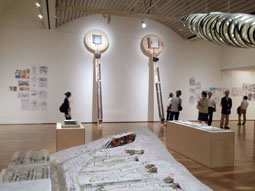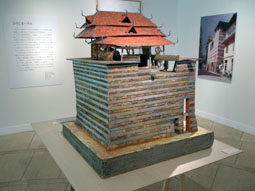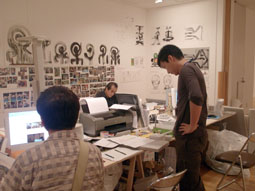 |
 |
HOME > FOCUS > Minority Report: Osamu Ishiyama's 12 Architectural Visions |
 |
 |
 |
 |
Focus features two in-depth reviews each month of fine art, architecture and design exhibitions and events at art museums, galleries and alternative spaces around Japan. The contributors are non-Japanese art critics living in Japan. |
|
|
 |
 |
 |
Minority Report: Osamu Ishiyama's 12 Architectural Visions
Thomas Daniell |
 |
 |
|
 |
| Farming Community Network model (foreground). |
|
Model of Hiroshima House, Phnom Penh. |
Osamu Ishiyama (1944-), an outsider architect who tends to work for outsider clients (the disabled, the deviant, the disenfranchised), is an exemplary member of the so-called "Red School" of Japanese architecture. A classification championed by historian Terunobu Fujimori, himself a high-profile Red School dilettante, the Red School is the subversive alternative to the more mainstream White School -- the former defined as visceral, warm, heavy, thick, rough, handmade, the latter as cerebral, cool, light, sharp, transparent, machined. The distinction isn't always easy to make: a slight shift of viewpoint places Tadao Ando's geometrical compositions of raw concrete in either camp (Fujimori calls him "pink"), and since the turn of the millennium Toyo Ito seems to have abandoned purest White for a trajectory through ever-deepening Red. Ishiyama himself has produced work of such range that the Red label is best seen as an ideological stance rather than a stylistic palette.
Ishiyama was a student of Takamasa Yoshizaka, a professor at Waseda University who worked for Le Corbusier during the early 1950s. Yoshizaka brought back his experiences with the expressionism and vernacular forms that define Corbu's work in India, and his students include several key figures in Japan's Red School. Characterized by the incorporation of traditional materials and craft techniques, client involvement in the construction process, intuitive on-site improvisation, perpetual incompletion, and an endearing awkwardness of form, the Red School tends to emphasize processes above results. For Ishiyama's first, long-overdue, solo exhibition, he has put the design process itself on exhibit. Throughout the exhibition, a part of Ishiyama's office (which is also his university laboratory) has been relocated to the Setagaya Art Museum. Visitors pass through the first two galleries of drawings and models, only to find Ishiyama himself and a handful of staff working at tables in the third.
The gallery spaces are lined with many hundreds of Ishiyama's sketches, clustered into variations on particular shapes or particular media. They range from crayon sketches on random-sized pieces of paper pinned to the wall -- like the work of happily deranged kindergarten students -- to framed copperplate prints of great precision and beauty. As well as designs for sites outside Japan (Cambodia, China, Chile, Mexico, Myanmar), the "12 Architectural Visions" of the exhibition title include two of Ishiyama's most celebrated projects. One is Hiroshima House in Phnom Penh, built in collaboration with the city of Hiroshima as an institution dedicated to world peace and as a memorial to the victims of Pol Pot. The result of worldwide volunteer efforts, it was effectively begun in 1996 and provisionally completed in 2007. The other is Setagaya-mura, Ishiyama's own house, begun in 1997 and unlikely ever to be finished in any conventional sense. Built over an existing old house and subject to constant minor modifications and extensions (much of the labor is carried out by Ishiyama's students), the ad lib, ad hoc flow of construction here (and throughout his work) is, for Ishiyama, Buddhist in sensibility -- indeed, his approach is reminiscent of Michael Rotondi, California's most famous Buddhism-inspired architect, who also spent years improvising on his own house in Los Angeles.
Ishiyama maintains a blog on the state of Setagaya-mura and his attendant experiments in self-sufficient sustainability. The gardens on the rooftop and adjacent to the building are, Ishiyama admits, largely symbolic, but he has been looking into the creation of links with other autonomous, off-grid agricultural projects in Japan. This is the basis for the Farming Community Network, perhaps the most visionary of the "12 Visions" on display in the exhibition. Here, Ishiyama leaves poetic, aleatory shape-making and expands his minority architectural convictions to society at large.
 |
|
 |
| Gallery interior. |
|
Model of Gen'an villa, Aichi Prefecture. |
|
|
|
 |
|
 |
| Sketches by Ishiyama. |
|
Ishiyama and staff at work.
All photos by Thomas Daniell |
|
 |
 |
Thomas Daniell
Thomas Daniell is a practicing architect based in Kyoto. He is currently an associate professor at Kyoto Seika University and an editorial consultant for the Dutch publications Volume and Mark. His book After The Crash: Architecture in Post-Bubble Japan is forthcoming from Princeton Architectural Press. |
|
 |
|